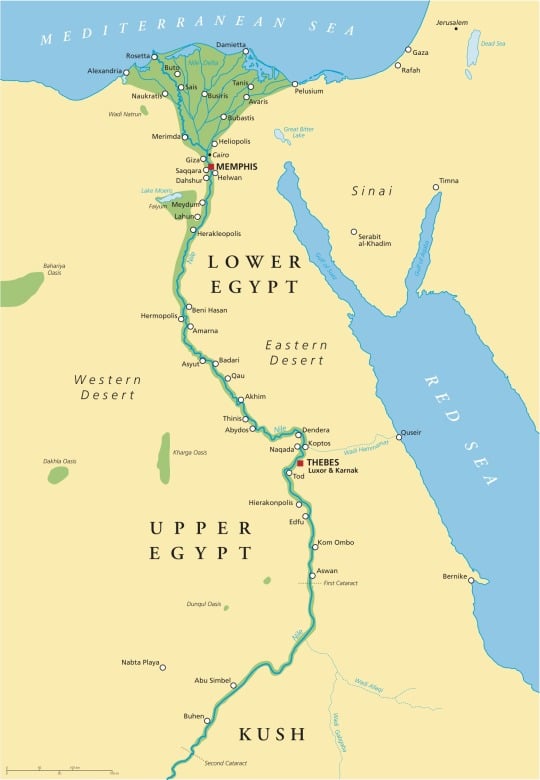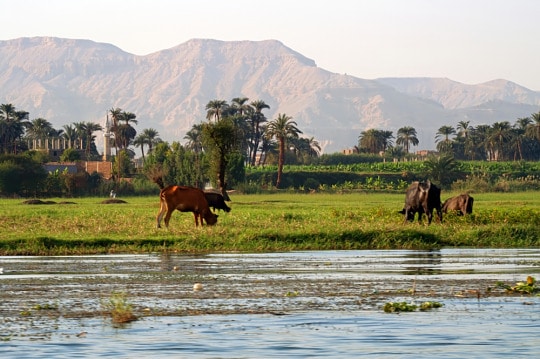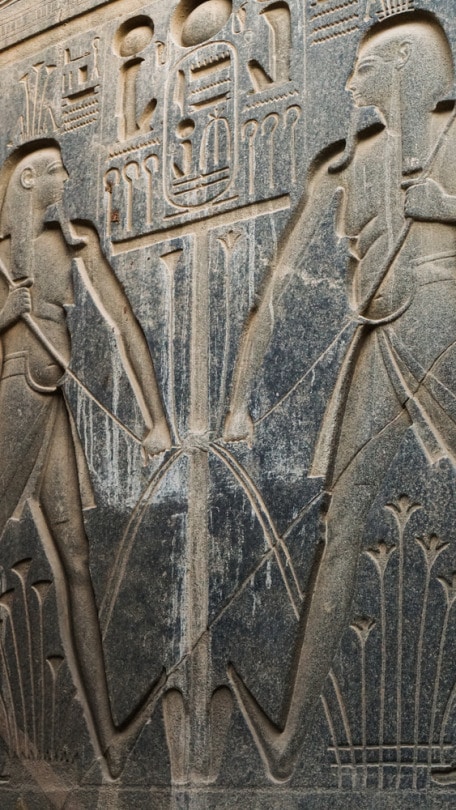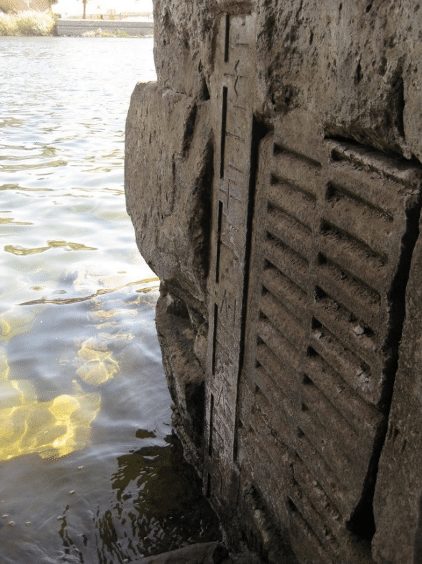What Are Cataracts In Egypt
Over the course of some five millennia the ancient Egyptians developed a distinctive textile culture shaped in large function by their local geography, natural resource, and relationship with the Nile River. In the fiveth Century BCE, the Greek historian Herodotus noted that "whatsoever sensible person" could meet that Lower Arab republic of egypt was a "souvenir of the river" (Herodotus, two.5). While his comments were express to the areas in the due north and in the Delta, they really ring truthful for all the Nile River Valley. Every aspect of life in Egypt depended on the river – the Nile provided food and resource, state for agronomics, a ways of travel, and was disquisitional in the transportation of materials for building projects and other big-calibration endeavors. It was a critical lifeline that literally brought life to the desert.

The modern name of the Nile River comes from the Greek Nelios, merely the Egyptians called it Iteru or "River." The Nile is the longest river in the globe, measuring some 6,825 km. The Nile River Organization has 3 main branches – the White Nile, the Blue Nile, and the Atbara river. The White Nile, the river'south headwaters, flows from Lake Victoria and Lake Albert. The Blue Nile brings nigh the inundation or annual overflowing and provides most of the river's water and silt. The Atbara river has less of an bear upon, as it flows but occasionally.
In the south, the Nile has a series of six main cataracts, which begin at the site of Aswan. A cataract is a shallow stretch of turbulent waters formed where flowing waters meet resistant rock layers. In the instance of the Nile cataracts, large outcroppings of granite make the catamenia of the river unpredictable and much more difficult to traverse by boat. The cataract system created a natural purlieus at Aswan, separating Egypt from its southern neighbor, Nubia.
Ancient Egypt was located in Northeastern Africa and had 4 articulate geographic zones: the Delta, the Western Desert, the Eastern Desert, and the Nile Valley. Each of these zones had its own natural environs and its own role within the Egyptian State. Cities could just flourish in the Nile Delta, the Nile Valley, or desert oases, where people had admission to water, country, and key resources. The ancient Egyptians, who were always peachy observers of nature, often associated the Nile Valley with life and abundance and the neighboring deserts with decease and anarchy.
Kemetor, "black state," denotes the rich, fertile land of the Nile Valley, whileDeshret, or "cherry country," refers to the hot, dry desert. The dissimilarity betwixt the scarlet land and the black land was non just visible or geographic, it effected the Egyptians' everyday lives. The dry climate of the desert, for case, made it an ideal location for cemeteries. There, the annual Nile inundation would not disturb people's graves and the dry climate acted to preserve tombs and their contents. Skillful preservation and the fact that nigh people exercise not alive in the desert, are the main reasons that so much of what archaeologists and anthropologists study comes from a funerary context.

The landscapes of Upper and Lower Egypt also differ. The Egyptian give-and-take Tawy, means "Two Lands" – this refers to the two main regions of ancient Egypt, Upper and Lower Egypt. Lower Egypt is in the north and contains the Nile Delta, while Upper Egypt contains areas to the South. These two designations may seem counterintuitive to their physical locations, only they reflect the flow of the Nile River, from Southward to Due north.
The expansive floodplain of the Nile Delta and the very narrow ring of fertile country present in the Nile Valley led to different ways of life. In the Nile Delta for example, the Egyptians synthetic their towns and cemeteries on turtlebacks; natural highpoints in the mural that became islands during the inundation. In improver, the location of the Delta forth the Mediterranean and at the entry point into the Levant fabricated it an of import area for trade and international contacts. The Delta was a very multi-cultural region throughout Egyptian history.

The Egyptians thought of the king as the unifier of the "Two Lands." One of the king'due south master roles was to keep Upper and Lower Arab republic of egypt united; the Egyptians expressed this visually using something we phone call the sema-tawy motif. Hither you lot can see two Nile gods symbolically uniting the lands of Upper and Lower Egypt – each depicted in the form of their characteristic institute, the papyrus for Lower Egypt and the lotus for Upper.
The Egyptians synthetic their calendar effectually the yearly wheel of the Nile. It included three main seasons: Akhet, the period of the Nile'southward flood, Peret, the growing flavour, and Shemu, harvest season. The Egyptians made Nilometers to measure and track the pinnacle of the annual flood – they used the recorded readings from these Nilometers much similar more than contemporary farmers would apply almanacs. One particularly well-preserved example is located on Elephantine Island at Aswan.
The close connexion betwixt the Egyptians the Nile River led them to identify a number of Egyptian gods with aspects of the river, its almanac flood, and the fertility and affluence associated with them. Hapi, for example, is the incarnation of the life strength that the Nile provides; he also symbolizes the almanac inundation of the Nile. His round belly and folds of pare represent abundance. Osiris, who is almost often recognized in his role associated with the afterlife, is fundamentally a god of regeneration and rebirth. Artists oft depicted him with blackness skin, linking him to the fertility of the Nile River and its lifegiving silt. The broader natural world was a further source of inspiration for Egyptian religion.

The Nile was also an important highway, information technology was the easiest fashion to travel and played an essential role in mining expeditions, merchandise, architectural projects, and general travel. The Egyptians were proficient boat builders; images of boats are some of the earliest designs that announced on Egyptian Predynastic Vessels dating to ca. 3500-3300 B.C.Due east. River access decreased the time and number of individuals needed for the transportation of large objects, similar stones, obelisks, and architectural elements. Boats were also common in the funerary religion besides – as a part of the funeral itself and for the afterlife.
Although I've only been able to touch on a few key elements here, the natural environs of Arab republic of egypt and the Nile River impacted every aspect of life in ancient Arab republic of egypt. The river's floodplain, water, and silt provided the foundation for civilization and served as a source of inspiration for the people who inhabited northeastern Africa during this pivotal period in history.
Lisa Saladino Haney is Postdoctoral Assistant Curator of Egypt on the Nile at Carnegie Museum of Natural History. Museum employees are encouraged to web log almost their unique experiences and knowledge gained from working at the museum.
Related Content
Ancient Egypt Through Its Pottery
Where the Heck Did That Come From?
Snails in the Desert
What Are Cataracts In Egypt,
Source: https://carnegiemnh.org/egypt-and-the-nile/
Posted by: colemanallse1994.blogspot.com


0 Response to "What Are Cataracts In Egypt"
Post a Comment